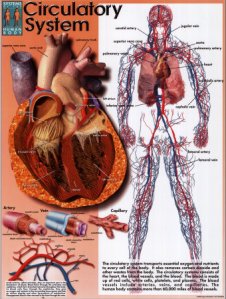The Cardiovascular System: Difference between revisions
No edit summary |
No edit summary |
||
| Line 17: | Line 17: | ||
===== Veins ===== | ===== Veins ===== | ||
In contrast to the arteries, veins have thinner walls and are therefore more flexible. These properties arise from the low blood pressure within veins, causing the blood flow to be much slower. A further characteristic of veins are the valves they contain, which are made from endothilium tissue and restrict the blood flow into one direction.<ref name="parker" /> Valves | In contrast to the arteries, veins have thinner walls and are therefore more flexible. These properties arise from the low blood pressure within veins, causing the blood flow to be much slower. A further characteristic of veins are the valves they contain, which are made from endothilium tissue and restrict the blood flow into one direction.<ref name="parker" /> Valves contain of two cusps that only open into the direction of blood flow due to pumping of the heart. | ||
This is especially important regarding their function, as this is to return deoxygenated blood to the heart. The main two veins doing this are called superior and inferior venae cavae.<ref name="parker" /> | This is especially important regarding their function, as this is to return deoxygenated blood to the heart. The main two veins doing this are called superior and inferior venae cavae.<ref name="parker" /> | ||
Revision as of 13:32, 2 December 2011
The Cardiovascular System (also called circulatory system) circulates the blood around the body in order to supply all parts with required nutrients and

oxygen and to remove waste products such as carbon dioxide [1]. Consequently it is crucial of the body's maintenance of homeostasis.[2]
In order to carry out its functions, the cardiovascular system pumps blood through the blood vessels. This is done by the pumping of the heart. Furthermore, the circulatory system is associated with other systems in the body, for example the lymphatic system.[1]
Blood and Blood Vessels
Blood consists of white blood cells, red blood cells, platelets and liquid plasma. Plasma accounts for about 50% of the total blood content and contains mainly water which has glucose, enzymes and other proteins, hormones and waste products dissolved in it. Oxygen and carbon dioxide are also present in the blood and are carried by the red blood cells.[1]
Within the human body, blood is carried in blood vessels which can differ in size and makeup [1].
Arteries
innitiate from the heart and carry blood to organs and tissues where oyxgen and nutrients are needed. Therefore, they carry blood which is rich in these components. The arteries pump blood by narrowing as the heart relaxes, so that the exerted force pushed the blood forward. Thick walls, muscular (see cardiac muscle), and elastic layers ensure that the strain due to the blood flow and the contraction of the heart does not damage the walls, which on average are only 1mm thick [1].
Veins
In contrast to the arteries, veins have thinner walls and are therefore more flexible. These properties arise from the low blood pressure within veins, causing the blood flow to be much slower. A further characteristic of veins are the valves they contain, which are made from endothilium tissue and restrict the blood flow into one direction.[1] Valves contain of two cusps that only open into the direction of blood flow due to pumping of the heart.
This is especially important regarding their function, as this is to return deoxygenated blood to the heart. The main two veins doing this are called superior and inferior venae cavae.[1]
Capillaries
As the distance of the blood vessels to the heart increases, the amount of branching increases and the blood vessels become smaller and finer in order for the blood to reach every part of the body. Starting with large arteries, these blood vessels then further divide into little vessels called capillaries (0.01 mm in diameter). Not only the size decreases but also the thickness of the walls decreases to a layer of only one cell so that a maximum exchange of gases with cells and tissues can be achieved.[1]
The capillaries carrying waste products away from the cells and tissues eventually enlarge into veins which carry the blood back to the heart.[1]
Heart Structure
Coronary Heart Disease
References